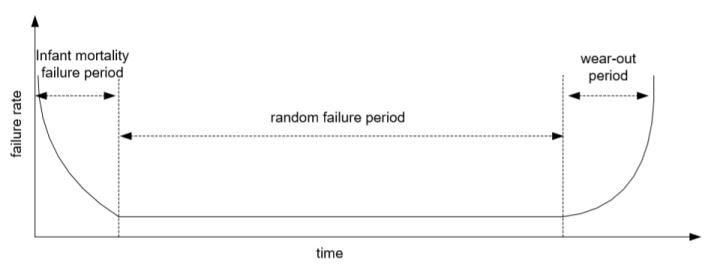Investigating failures in building services
Contents |
[edit] Introduction
A study from the UCL(1) revealed that building failures may cost the UK construction industry £1bn to £2bn every year. This was a conservative estimate made in 2016, based on 1 to 2% of the total value of construction.
As of March 2020, the Office for National Statistics has estimated the total value of all UK construction works to be worth £12.7bn, 68% of which is for new buildings or the repair and maintenance of existing buildings. This would give an estimated cost of failure between £85m and £170m, of which building services would account for a high proportion.
[edit] Types of failures in building services
Diagram courtesy of BSRIA; not for reuse.
The typical pattern of failure arising against time is shown by the well-known bathtub curve, which is divided into three segments or periods.
The first period is usually detected during the defects liability period after a project is handed over.
The second period would happen during the operation of a system, and failures may occur due to inappropriate operating conditions or maintenance regimes.
The third period is when the system is reaching the end of its life. Failure could be imminent and there should be little or no surprise in this happening.
[edit] Importance of investigating these failures
There are various reasons why every unexpected failure should be investigated. Below are some of the key ones:
- Insurance purposes. Insurers may require an independent evaluation of the failure and investigation of its possible cause to identify possible fraudulent or malicious intentions.
- Cost savings. Too often, failed components are replaced without investigating the root cause. Without understanding the origin of a failure, it is not possible to prevent its re-occurrence. Repetitive failure and replacement of components could add significantly to the operating cost for a building or estate.
- Health and safety. In May 2009, a lift at London’s Tower Bridge tourist attraction suffered a vital mechanism failure that sent it falling with nine people in it, four of whom suffered bone fractures. The malfunction was caused by the failure of a counterweight mechanism. The accident investigation by the HSE revealed that there had been several previous component failures with the counterweight mechanism, and the components had been replaced without proper review, and with no investigation into why they were failing so early. Tower Bridge was ordered to pay a total cost of £100k, and the HSE concluded that, had there been a proper review into the counterweight mechanisms, the catastrophic failure of the lift could have been avoided.
Read more about BSRIA’s Failure Investigation service here.
(1) Razak, D S A, Mills, G and Roberts, A (2016) External Failure Cost in Construction Supply Chains. In: P W Chan and C J Neilson (Eds.)
This article was originally published as The importance of investigating failures in building services on the BSRIA website on 20 May 2020. It was written by Martin Ronceray, BSRIA Engineering Investigation Lead.
--BSRIA
[edit] Related articles on Designing Buildings Wiki
- BSRIA articles on Designing Buildings Wiki.
- Cracking and building movement.
- Defects.
- Failure.
- Failure modes and effect analysis (FMEA).
- Inspection and test plan.
- Latent defects.
- Structural failures.
- Why should quality be important to the construction industry/
Featured articles and news
The UK's Modern Industrial Strategy: A 10 year plan
Previous consultation criticism, current key elements and general support with some persisting reservations.
Building Safety Regulator reforms
New roles, new staff and a new fast track service pave the way for a single construction regulator.
Architectural Technologist CPDs and Communications
CIAT CPD… and how you can do it!
Cooling centres and cool spaces
Managing extreme heat in cities by directing the public to places for heat stress relief and water sources.
Winter gardens: A brief history and warm variations
Extending the season with glass in different forms and terms.
Restoring Great Yarmouth's Winter Gardens
Transforming one of the least sustainable constructions imaginable.
Construction Skills Mission Board launch sector drive
Newly formed government and industry collaboration set strategy for recruiting an additional 100,000 construction workers a year.
New Architects Code comes into effect in September 2025
ARB Architects Code of Conduct and Practice available with ongoing consultation regarding guidance.
Welsh Skills Body (Medr) launches ambitious plan
The new skills body brings together funding and regulation of tertiary education and research for the devolved nation.
Paul Gandy FCIOB announced as next CIOB President
Former Tilbury Douglas CEO takes helm.
UK Infrastructure: A 10 Year Strategy. In brief with reactions
With the National Infrastructure and Service Transformation Authority (NISTA).
Ebenezer Howard: inventor of the garden city. Book review.
The Grenfell Tower fire, eight years on
A time to pause and reflect as Dubai tower block fire reported just before anniversary.
Airtightness Topic Guide BSRIA TG 27/2025
Explaining the basics of airtightness, what it is, why it's important, when it's required and how it's carried out.
Construction contract awards hit lowest point of 2025
Plummeting for second consecutive month, intensifying concerns for housing and infrastructure goals.
Understanding Mental Health in the Built Environment 2025
Examining the state of mental health in construction, shedding light on levels of stress, anxiety and depression.
























